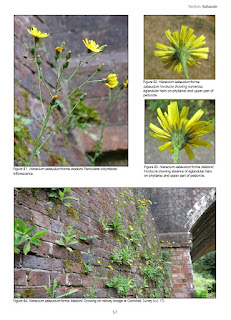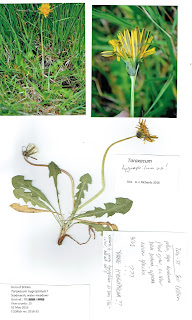 |
| The cover of Hawkweeds of south-east England |
There’s a new addition to the series of BSBI Handbooks. Handbook no.20 Hawkweeds of south-east England is due
to be published in April and botanists will be able to benefit from an
exclusive introductory offer of £25.50 (plus P&P) which will save them £9.50
compared the RRP of £35.00.
There has been a previous Handbook dedicated to hawkweeds,
but it focused on section Alpestria. This new Handbook will be the first one to
focus on those species found in one geographical area, south-east England. I
caught up with author Mike Shaw and asked him to tell us a bit more about Hawkweeds
of south-east England.
LM: Mike, the new book is 250 pages long and covers the 58
species that have been recorded in the south-east of England. When did you
start working on the book?
MS: This was back in 2015 Louise. I had developed an
interest in hawkweeds while recording for and writing the Hieracium species
accounts for the new Flora of Sussex.
 |
| Mike Shaw examines a stand of Hieracium neosparsum in Kirdford |
LM: Ah this was while you were BSBI’s County Recorder for West Sussex?
MS: Yes, I realised from my own observations and feedback
from fellow botanists that little was known about the distribution of hawkweeds
in Sussex, and in south-east England generally, and thought that a book to
provide further information on this and help with identification would be
welcomed.
LM: Could you give us an example please of one of the
species you cover and what we can expect to find out from the new Handbook
about its identification, distribution and current status?
 |
| Sample page with photos, notes on ID and distribution, and map |
LM: You must have visited a lot of locations across the
south-east in the course of your research. Are there any that particularly
stand out in your memory?
MS: Yes, I certainly covered a lot of ground. The Hieracium
pollichiae which has adorned the walls of the Bishop’s Palace gardens in the
grounds of Chichester Cathedral for 200 years is impressive, but Box Hill in
Surrey must stand out as the best hawkweed location in south-east England, not
only for its natural beauty but for the sheer number of species which have been
recorded on and close to it—19 out of the total of 58 found in south-east
England.
LM: How about herbaria
– I think you also looked at herbarium specimens?
 |
| Sample pages with herbarium specimens & images |
MS: Yes, I have visited several herbaria including BM, CGE, MNE,
HCMS, BTN and PTM, most on more than one occasion [LM.: these are the codes for the various herbaria.]. I have also corresponded
with others, both at home and abroad, such as OXF, NMW, S, LU, LY and ANG. In all
cases I have found the curators extremely helpful in providing access to
specimens, scanning and photographing specimens and responding to specific enquiries.
Study of herbarium collections is crucial to understanding
the variation within critical species, and in many cases allows examination of
type specimens upon which the original species descriptions were based. British
herbaria are a vital resource, and some of the smaller ones are under financial
threat of closure. The more botanists visit and use herbaria collections the
more likely their future will be secured.
 |
| Sample page with close-ups and images of plants in situ |
LM: Illustrations are an important part of any BSBI Handbook
and I see that Hawkweeds of south-east England is illustrated with more than
400 full colour photographs. Who provided them – were you the photographer as
well as the author?
MS: Many of the photographs are mine. There is a scanned or
photographed image of a herbarium specimen for each species and these were mostly
done for me by the curators at BM and CGE. Where the specimens themselves were not
from my own herbarium the source is credited in the image caption. Most of the
detailed micro-photographs were done for me by John Hunnex at BM and I am
indebted to him for his time and patience while we worked together on them.
 |
| Sample page shows notes on geology and a coincidence map showing number of hawkweed species per hectad |
MS: All the distribution maps in the book were produced by
me using DMAP software (by Alan Morton). There are maps for each species in south-east
England based on verified data. The data sources (including the BSBI Distribution
Database) and validation methods are fully explained in the book. Additionally,
there are maps showing the wider distribution of locally extinct species in Britain
and Ireland, and coincidence maps for several hawkweed sections, all based on data
collated and shared by David McCosh.
LM: And I’m guessing that you also got a lot of feedback
from BSBI County Recorders and many
of our “ordinary members” who go out plant recording?
MS: Yes Louise, they all thought I was mad tackling
hawkweeds! Seriously though, the enthusiastic support from the neighbouring County
Recorders — Martin Rand, Tony Mundell, Ann Sankey, Geoffrey Kitchener and Colin
Pope — when I first discussed my plan to write this book with them, gave me lots
of reassurance. They were happy to provide detailed information, they collected
specimens for me and often joined me on field trips.
 |
| Leaves of various hawkweeds |
I had received tremendous support from members of the Sussex Botanical Recording Society with
the Flora of Sussex and this continued throughout work on the hawkweeds Handbook.
There is insufficient space here, but many other people who have provided
generous and invaluable contributions are acknowledged at the start of the book.
LM: Botanists are a helpful bunch! Finally: all BSBI authors benefit from an editor to help
them through the process towards publication. Who was your editor?
MS: I was very fortunate to have Tim Rich as my editor. He devoted
a huge amount of time to reading the drafts and offering many suggestions for
revisions and improvements based on his wide knowledge of hawkweeds
specifically, and as an experienced author. The book is much improved and more
accurate thanks to his input.
 |
| Tim Rich, Mike's editor on Hawkweeds of south-east England, with Attenborough's Hawkweed |
LM: For anyone who is new to
British and Irish botany: Tim is the author of numerous BSBI Handbooks
and scientific papers about
hawkweeds (and many
other plants!), the co-editor of the Plant
Crib and a regular
contributor to this News blog. You may have seen Tim
on television a few years ago when he presented a potted specimen of Attenborough's Hawkweed Hieracium
attenboroughianum, the hawkweed he
discovered and named
after his natural history hero, to Sir David himself.
I asked Tim what he thought about Hawkweeds of south-east
England and he said: "What a fantastic contribution to make hawkweed
identification in South-east England clear and accessible - I hope this will
inspire others to get out and look at hawkweeds and enjoy these wonderful
plants"
 |
| Sample page with detailed ID notes for Hieracium vagum |
So, thanks to Tim Rich for his editorial contribution and
thanks to author Mike Shaw for talking to us about the forthcoming BSBI Handbook.
We’d like to congratulate you both and thank you for all the hard work that has
gone into this new addition to BSBI’s
publications portfolio.
Can’t wait to see the book once it’s published!
Now you just need to know how to get hold of a copy of the
new BSBI Handbook.
Please head over to this page and use
the secure PayPal facility below if possible. You don’t need to have a PayPal
account in order to pay this way: it’s quick and easy for you and it’s
efficient for us.
Another option is to fill in the order form which you will
find on the same page and post it, along with a cheque made out to BSBI, to
BSBI Membership Secretary Gwynn Ellis. We hope you enjoy Hawkweeds of south-east England!













